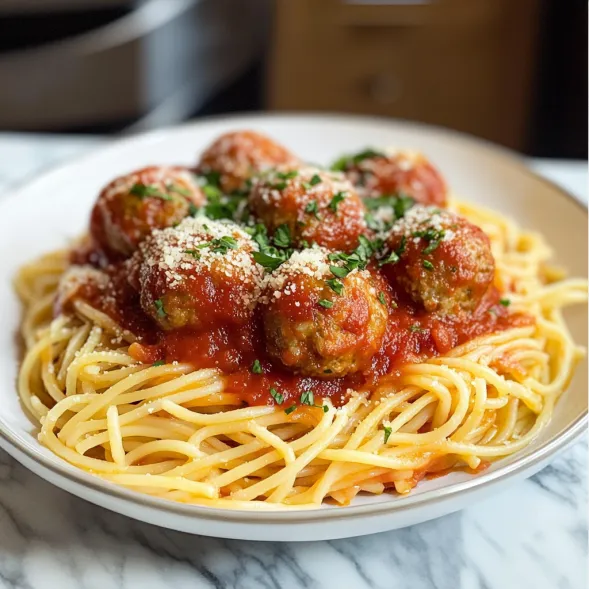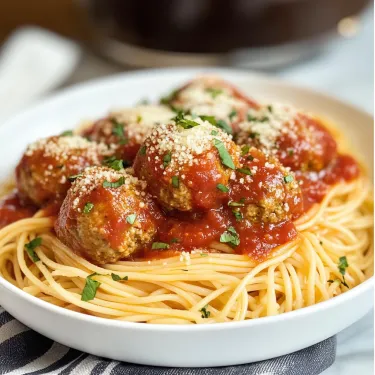 Bookmark
Bookmark
These tender turkey meatballs simmered in a rich marinara sauce are the ultimate comfort food. Browning the meatballs before adding them to the crockpot enhances their flavor and helps them hold their shape, ensuring they're perfectly juicy and delicious. As I've previously mentioned, ground turkey is a wonderful ingredient to use in your recipes if you're trying to eat a little healthier!
I first made these meatballs for my picky nephews who claim to hate "healthy food" and they devoured them without even realizing they were turkey instead of beef. Now this has become my go to potluck dish that always disappears first.
Ingredients
- Ground turkey provides lean protein while staying incredibly tender and juicy
- Breadcrumbs help bind the meatballs and create the perfect texture
- Parmesan cheese adds depth and savory flavor that complements the turkey
- Fresh parsley brightens the meatballs and adds beautiful color contrast
- Marinara sauce use your favorite jarred variety to make this recipe super simple
- Diced tomatoes add texture and freshness to the sauce as it slowly simmers
Step-by-Step Instructions
- Prepare the Meatball Mixture
- Combine ground turkey, breadcrumbs, parmesan, egg, parsley, garlic, onion powder, oregano, salt and pepper in a large bowl. Mix with gentle hands just until the ingredients come together. Overmixing will make your meatballs tough, so stop once everything is incorporated.
- Shape the Meatballs
- Scoop approximately two tablespoons of mixture and roll between your palms to form 1½ inch balls. Slightly wet hands prevent sticking and create smoother meatballs. This recipe should yield about 24 uniform meatballs.
- Brown for Flavor Development
- Heat olive oil in a large skillet over medium high heat until shimmering. Add meatballs in a single layer, working in batches if needed, and brown for about 2 minutes per side. This crucial step creates a flavor crust and helps them maintain shape during slow cooking.
- Layer in the Crockpot
- Transfer browned meatballs to your slow cooker. Pour marinara sauce and diced tomatoes over the top, then sprinkle with basil, red pepper flakes, garlic powder, salt and pepper. Gently stir to ensure all meatballs are coated in sauce.
- Slow Cook to Perfection
- Cover and cook on low for 6 to 7 hours or high for 3 to 4 hours. The slow cooking process allows the flavors to meld together while keeping the meatballs incredibly tender and juicy.
 Bookmark
Bookmark
The secret ingredient that makes these meatballs special is the combination of parmesan cheese and parsley. When my Italian grandmother first tasted them, she was genuinely surprised I had made them with turkey instead of her traditional beef and pork blend. She actually asked for the recipe, which I consider the highest compliment possible!
Make Ahead Options
These meatballs are perfect for meal prep. You can form the raw meatballs and store them in the refrigerator for up to 24 hours before browning and slow cooking. For even more convenience, brown the meatballs then cool completely before freezing them on a baking sheet. Once frozen, transfer to a freezer bag where they'll keep for up to 3 months. When ready to use, simply place the frozen browned meatballs directly in your crockpot with the sauce and increase cooking time by about 30 minutes.
Serving Suggestions
While classic spaghetti is always a hit, these meatballs are incredibly versatile. Try them in meatball subs with melted provolone cheese, served over creamy polenta, or alongside roasted vegetables for a lower carb option. For a fun appetizer variation, keep the meatballs warming in the crockpot and provide toothpicks for guests to help themselves.
Dietary Adaptations
This recipe can easily accommodate various dietary needs. For gluten free meatballs, substitute gluten free breadcrumbs or crushed rice Chex cereal. If dairy is a concern, nutritional yeast provides a similar savory quality to the parmesan cheese. For an even leaner option, ground chicken breast can be substituted for the turkey, though you might need to add a tablespoon of olive oil to the mixture to prevent dryness.
 Bookmark
Bookmark
Frequently Asked Questions About Recipes
- → Can I skip the browning step for the meatballs?
While you technically can skip browning, it's highly recommended as it serves two important purposes: it develops a richer flavor through caramelization and helps the meatballs maintain their shape during slow cooking. The extra 10 minutes of prep time significantly improves the end result.
- → How can I make these turkey meatballs more moist?
To ensure moist turkey meatballs: don't overmix the meat mixture, include all the binding ingredients (egg, breadcrumbs, cheese), make sure to brown them before slow cooking, and cook them in the sauce where they'll absorb moisture. You can also add 1-2 tablespoons of ricotta cheese to the mixture for extra moisture.
- → What can I serve with these turkey meatballs?
These versatile meatballs pair wonderfully with traditional spaghetti, zucchini noodles for a lower-carb option, polenta, or simply alongside crusty garlic bread. They also make excellent meatball subs when placed in toasted rolls with melted cheese on top.
- → Can I freeze these turkey meatballs?
Yes! These meatballs freeze exceptionally well. Cool them completely with the sauce, then transfer to airtight containers or freezer bags. They'll keep for up to 3 months. Thaw overnight in the refrigerator and reheat on the stovetop or in the microwave until hot throughout.
- → Can I use store-bought meatballs instead of making them from scratch?
While homemade meatballs offer superior flavor and texture, you can substitute pre-made turkey meatballs to save time. Still brown them before adding to the slow cooker for best results. Cooking time may need to be adjusted depending on whether the pre-made meatballs are raw or pre-cooked.
- → How do I know when the turkey meatballs are fully cooked?
Turkey meatballs are fully cooked when they reach an internal temperature of 165°F (74°C). After the recommended slow cooking time (6-7 hours on low or 3-4 hours on high), they should be well above this temperature. You can verify with a meat thermometer if unsure.
